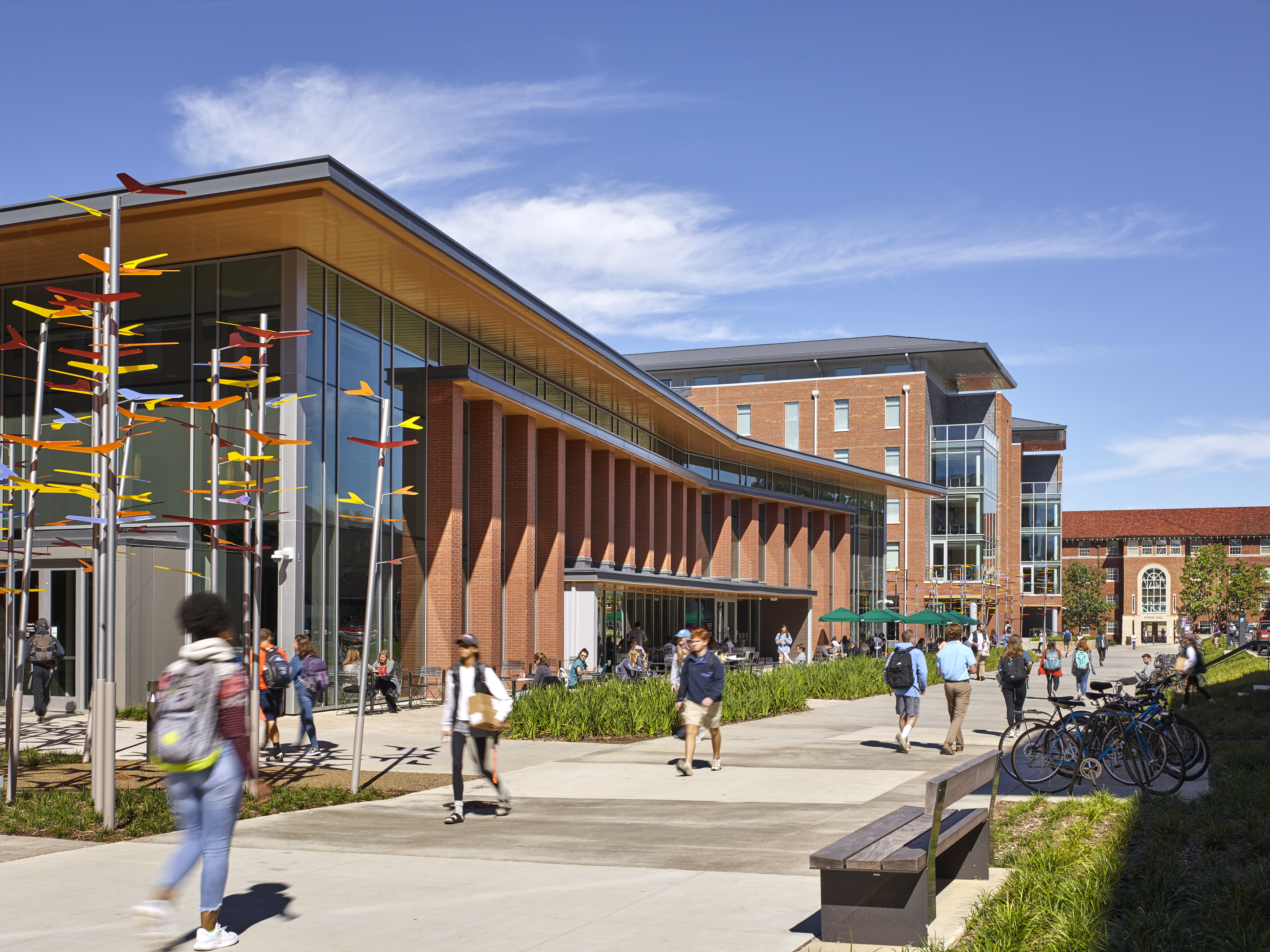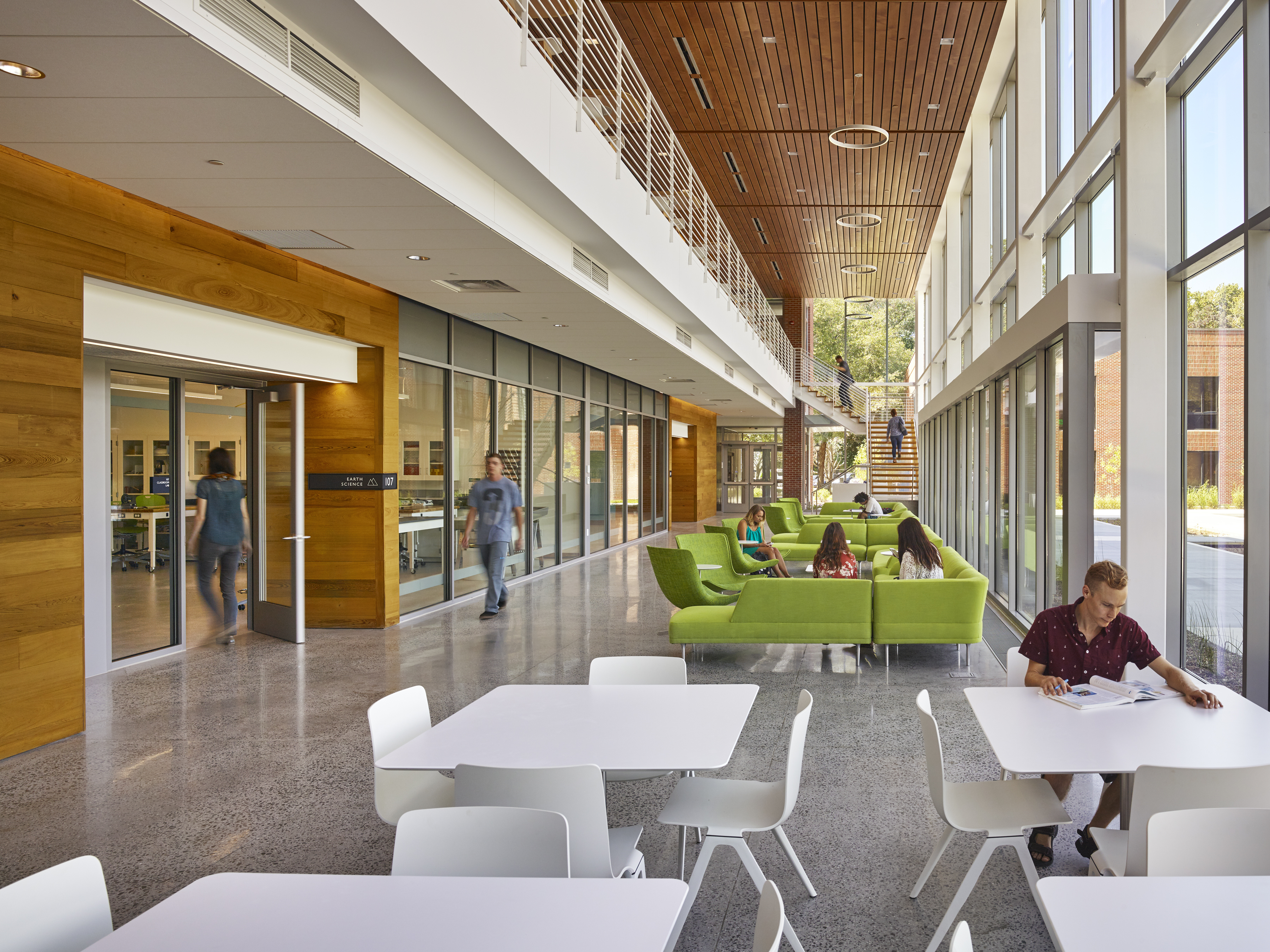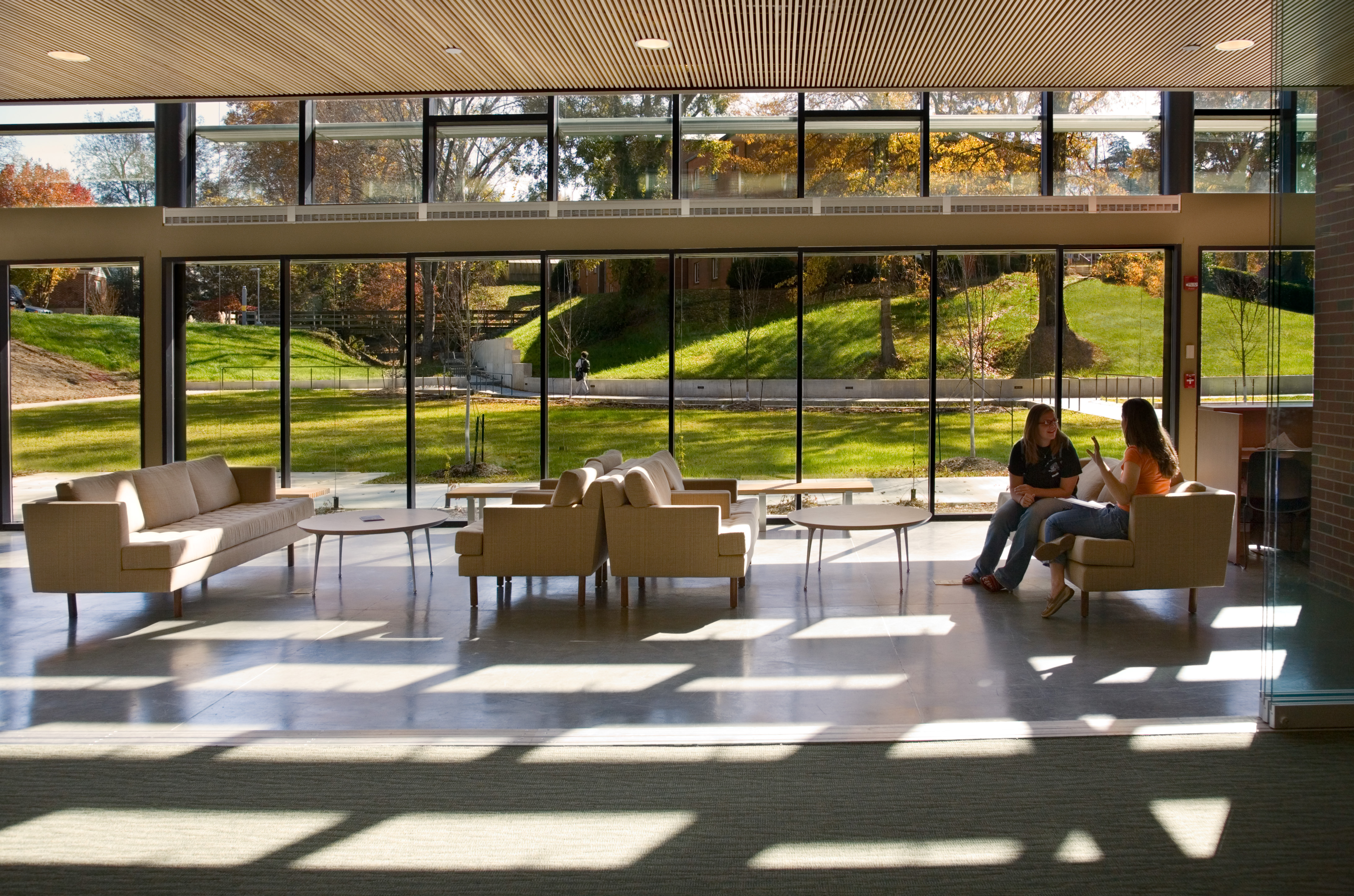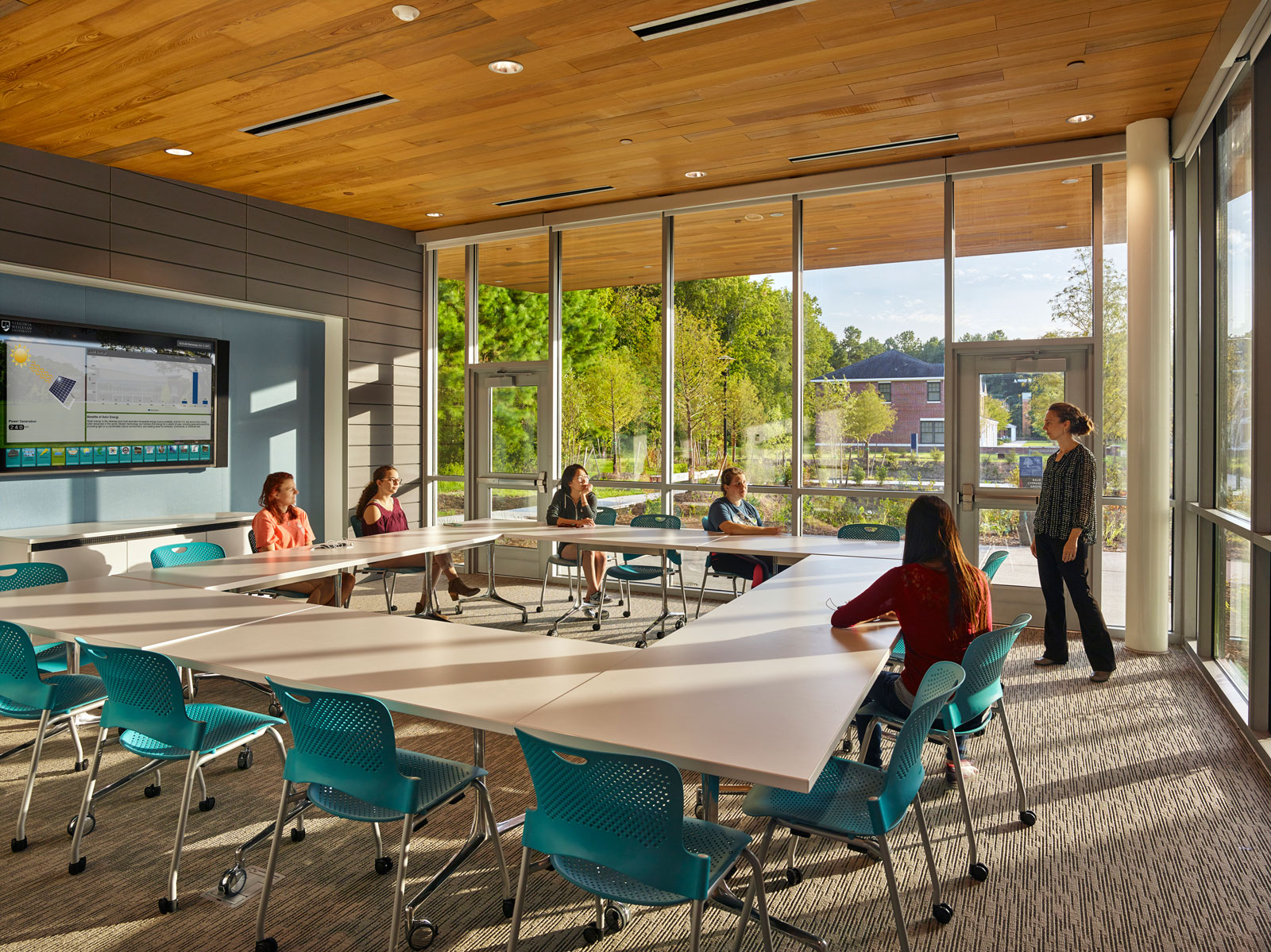As colleges and universities across the country begin a new semester in the midst of the COVID-19 pandemic, they are opening in a climate of uncertainty. The uncertainty about the immediate future is obvious and very much in the news these days: Will institutions that welcome students back to campus be able to remain open this fall? And will institutions that return online be able to keep students engaged?
However, the COVID-19 crisis also raises important questions about the longer-term future of higher education: Will the expansion of on-line learning change future delivery models? Will the financial set-backs that institutions are facing drive major changes in higher education overall? To think about the longer-term impact of the pandemic, we reached out to our friends Joe Winters and Brad Noyes of Brailsford & Dunlavey. VMDO has enjoyed a decades-long collaboration with Brailsford & Dunlavey on projects ranging from sports arenas to student unions to housing master plans. As strategic advisors to literally hundreds of higher education clients across the country, Joe and Brad have a broad and well-informed perspective on how the COVID crisis is affecting the overall landscape of higher education.
 Clemson University Core Campus Complex
Clemson University Core Campus Complex
Q1. Fraces Lengowski
How do you think the COVID-caused pause in on-campus life will impact institutions’ delivery of the college experience for Fall 2020 and beyond?
A1. Joe Winters
From what we've seen in many different vignettes, what happened this past spring has only confirmed the value of the on-campus learning environment.There's been a significant amount of effort made, to the extent possible in each unique situation, to create an in-person on-campus environment for the fall of 2020. We see that as a direct response to the spring – that really across the board for many campuses, from administrators and faculty, to students and their families, education in person is a key driver for the investment families want to make in college. We're seeing institutions step up to the challenge and try to understand the best way to safely respond to the need and desire for some form of on-campus physical community. With that said, providing an on-campus experience in light of COVID-19 is going to definitely change how existing facilities are utilized, future square foot per bed ratios, and the relationship between different programming elements. All these things have or will likely change, but what is very clear to us is that the desire and intent to deliver and participate in an on-campus experience is not going to go away any time soon.
The spring was also about beginning to develop and evolve a hybrid model – something blending online learning with the on-campus experience. There's no doubt moving forward that there will be a greater proportion of virtual learning within the “typical on-campus experience,” whether it's because of the investments made or the lessons that will be learned as a result of educating students through this pandemic. I think we're going to redefine what virtual learning and on-campus
A1. Brad Noyes
Universities and colleges are a mission-based cohort. They fully embrace their individual missions, and they are deeply committed to the societal value they provide. And because of that, there's a commitment – a strong commitment – driving their decisions for how to deliver a value of experience and education in this “new normal” condition.
Q2. Frances Lengowski
What major risks do you see colleges and universities needing to address head-on in the next few months and in the longer term?
A2. Brad Noyes
This crisis has made it necessary to think in three different planes at the same time: a one- to two-month horizon, a six-month horizon, and an 18-month to two-year horizon. Senior administrators have so much impacting the first and second horizons that they have very little bandwidth, leadership capacity, and strategic decision making to be able to still remain focused on the 18- to 24-month window. However, remaining focused on the 18- to 24-month window is especially important given that the volatility of potential outcomes for an institution over that time period is much greater than, perhaps, it once was.
The ability to effectively manage risk in a highly dynamic environment is as much about the decision-making framework that is in place, as it is about the information you have to act on.Given higher education’s highly dynamic current reality, institutions must respond by focusing on how to exist successfully in a more volatile environment rather than waiting for it to return to a more typical level of risk. There has to be an approach or a capacity to be nimble and responsive while still remaining focused on your mission and what you're trying to accomplish in the short, medium and “new normal” horizons.
So how do you respond to risk from a strategic perspective? Having a decision-making framework in place and partners who can act seamlessly because they are grounded in each unique situation is a big first step to meeting this challenge. In the end, it’s by thinking and acting through these three lenses simultaneously that major risks are most effectively addressed.
 Virginia Wesleyan University Greer Environmental Sciences Center
Virginia Wesleyan University Greer Environmental Sciences Center
Q3. Frances Lengowski
To what extent do you see the financial challenges of COVID-19 driving larger-scale shifts in the landscape of higher education?
A3. Joe Winters
The short-term challenges or financial hurdles that have been created are pretty evident. It’s the long-term impact to higher education as a sector that remains an unknown. If we go back to Brad's overview of planning at three different horizons, each institution would answer differently what their risks are in each of those horizons. And in a lot of cases, those institution-specific risks will dictate the long-term impact COVID has.
A3. Brad Noyes
For the sector at large, as Joe said, we know it's going to have an impact on everyone in the short term. And in the long term, it's likely to be more varied than consistent across the board. For institutions with fewer resources, a smaller endowment, less clarity, less consistency of mission, less of a decision-making framework, and less nimbleness, the impact may become so great that the institution may not make it. So if the question is, “will there be educational institutions who cannot respond to the opportunities and challenges presented by this difficult condition?” I think the industry's overall answer will be yes. On other end of the spectrum, we will likely see many institutions who seize those opportunities and challenges, have those things in place, and actually reposition themselves to a new condition that is even more responsive to and effective in their context? We believe the answer will be yes to both outcomes. You will see folks who come through this with a clarified sense of mission, a clarified sense of decision-making, a clarified sense of resource allocation, and a clarified sense of the key variables that position them to be successful.
Q4. Frances Lengowski
As colleges and universities plan to re-open in the fall, they are enacting a wide variety of strategies to minimize the spread of COVID-19. Do you think these will be short-term solutions? Or do you imagine some of these new strategies will have a long-term impact on campus planning and design?
A4. Joe Winters
There's a whole bevy of precautions or measures that institutions are planning to take if they are planning to welcome students back. These include social distancing, adjusting the timeframe of the semester, managing the number of times that students come to campus and leave campus, moving classes outside into tents, changing transportation routing, managing the planned occupancy of any residential inventory, creating extra vacancy in the housing system to quarantine infected students, expanding grab-and-go dining options, and limiting the capacity of gathering spaces like dining halls. While we can speculate as to which ones we think could have the most validity to remain in the long run, we don't actually know which ones will stick. Our guess is that they'll be different depending on the institution and how well this experiment goes. One example, there are changes to the academic calendar that we could certainly see continuing.
Without a doubt, we have received with increased frequency these last few months questions about the concept of residential unit typologies: do we now think about single occupancy versus double occupancy differently than we did three or four months ago? And how do we manage our inventory and build budgets for our housing system to be able to handle something like another COVID outbreak should it happen more frequently in the future? So the impact or ramifications of COVID certainly will not go away in the near term, but the extent and manner with which it doesn't go away is not currently able to be determined.
 Averett University Student Center
Averett University Student Center
Q5. Frances Lengowski
We are already seeing a major slow-down in the economy due to COVID-19. Of course, when the economy slows, the cost of borrowing and of building declines as well. How are you seeing colleges and universities respond to these market conditions?
A5. Brad Noyes
Institutions are prioritizing initiatives that enhance value and then accelerating or decelerating capital project initiatives relative to the requirements of their market condition. We have just as many clients who have called and said: “We need to speed up” as “We need to slow down”."It has become clear to us that this is mission-critical” or “We believe that a market opportunity will open up for decompression in the next six to 12 months” are common phrases.These clients are re-sequencing projects, changing the delivery structure, changing participants, and changing project management protocols in order to adjust to “We need to speed up” during highly dynamic market conditions.
We’ve also had institutions call and say: “We cannot handle the burden on our leadership and our staff to keep this initiative going at this time. Given all the other COVID impacts, this is not as critical to us in the immediate term, we would like to slow this one down. And we understand that this decision may come at a cost because we may end up on the other side of this opportunity when construction costs and financing costs could be higher.” Finally, we've had a third category of folks who have said: “Speed up and then give us a window where we can optimize this delivery.” We have multiple projects right now where clients are accelerating projects to get them shovel-ready so that whenever the financial and construction markets are optimized in that particular market, they are often creating as much as a six-month window in order to be able to take advantage of market conditions.
We think all of these observations come together to make an encouraging point. We really believe that higher education is thinking strategically during this challenging time and responding nimbly with a long-term focus, as much as they can, given all of the other things they have going on as they continue to seek to serve their mission.

